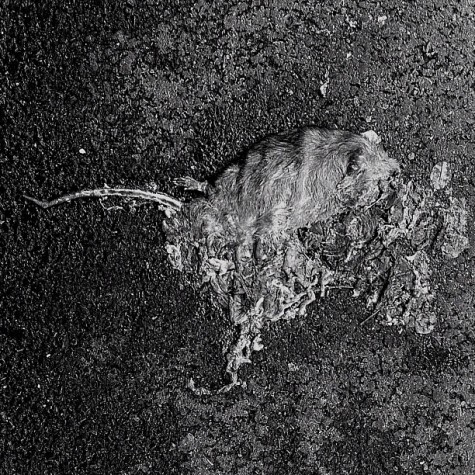You are currently browsing the tag archive for the ‘Ashley Gilbertson’ tag.
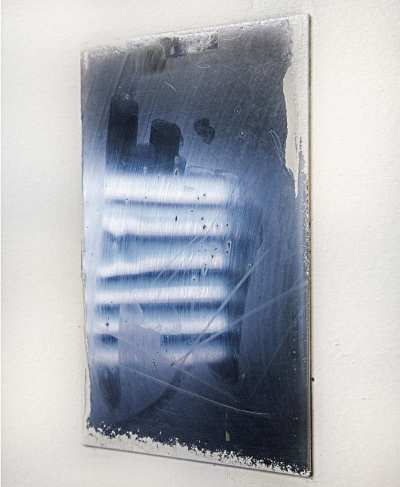
A small, unbreakable tin wall mirror in a solitary cell. Reflection is of a slatted window. Photo: Ashley Gilbertson/VII Photo for New York Magazine.
The suicide of Kalief Browder was the latest, most tragic reminder of how much of a hell hole Rikers Island is. It was the combined effects of broken bail and juvenile prison systems that killed Kalief.
Take your pick of the coverage from The Guardian and the New York Times, to New York Magazine. What has been consistent in the coverage of Rikers as information about conditions and treatment is that visuals have been limited and it has relied on the progression of lawsuits and news FOIA requests. Whistleblowers have been few and far between and prisoners’ testimonies are notoriously difficult to verify.
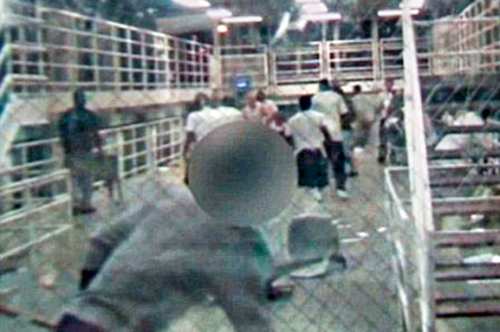
An August 2013 fight in the George R. Vierno Center, caught on surveillance tape.
That makes the recent feature Rikers Island, Population 9,790, a joint effort between The Marshall Project and New York Magazine noteworthy. In the expansive effort involving more than half a dozen journalists, we hear from a couple who both went to Rikers in the same year (she was pregnant); a teacher on Rikers; a couple of recent prisoners; an officer, the commissioner of the department of corrections; a girlfriend of a slain prisoner; a former volunteer-librarian; various visitors; a mental health professional; and others.
The selection of imagery (as well as an overview map) is one of the most diverse visual presentations of Rikers that I have seen online. It includes Ashley Gilbertson‘s straight shots from common areas, wings and solitary cells, Ruth Fremson‘s work from the kitchen, surveillance video stills, photos of prisoners by Clara Vannucci and Julie Jacobson, Instagram images found under the hashtag #Rikers, environmental studies by Librado Romero, and archival photos by my friend and former correctional officer Lorenzo Steele Jr.
Bravo to the photo editors of The Marshall Project and New York Magazine.
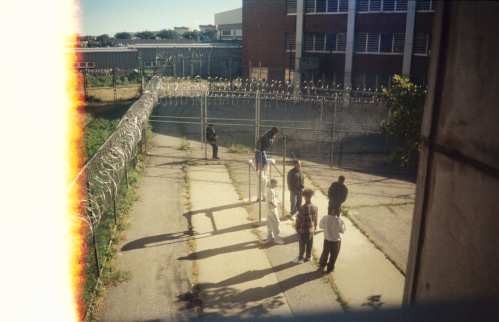
The recreation center at the bing. Photo: Officer Lorenzo Steele Jr.
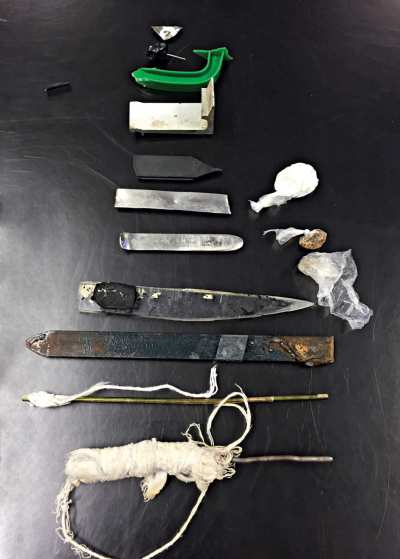
Contraband, including jail-made weapons and drugs. Photo: New York City Department of Correction via AP.

The view from Instagram, #Rikers: Clockwise from left: The bridge to Rikers; bathroom graffiti inside the vistors center; the new maximum-security wing; the entrace to a chapel; a correction officer at an adolescent unit; an exercise and recreation area. Photo: Kelsey Jorgenson/Edgar Sandoval/JB Nicholas/Bryan R. Smith/JR/Gee Force.

Prisoners at “Rosie’s” the women’s unit. Photo: Clara Vannucci.

Inside a solitary-confinement cell. Photo: Ashley Gilbertson/VII Photo for New York Magazine.

Mercedes Smith, a formerly incarcerated person, reads a letter from her currently imprisoned son, at a relatives house where she lives after working all day on July 13, 2012, in Manhattan New York. Ms. Smith is not allowed to live with her family while she is on bail because her mother still lives in the same building as where the crime took place. Ms. Smith served 20 years for 2nd degree manslaughter and was released in 2010. (Photo by Ashley Gilbertson / VII)
– – – – – – – – – – – – – – – – – – – – – – – – – – – – – – – – – – – – –
Think Outside The Cell, a NYC based advocacy group, and VII Photo Agency recently collaborated to create a media campaign to educate the public about the continued struggles for felons post-release. This conversation with Ashley Gilbertson is the final part of a five part series, ‘Ending The Stigma Of Incarceration.’
(Part One): Think Outside The Cell / VII Photo Partnership
(Part Two): A Conversation With Ron Haviv
(Part Three): A Conversation With Ed Kashi
(Part Four): A Conversation Wtih Jessica Dimmock
– – – – – – – – – – – – – – – – – – – – – – – – – – – – – – – – – – – – –
This text has been edited from longer conversation.
– – – – – – – – – – – – – – – – – – – – – – – – – – – – – – – – – – – – –
PP: In part four I spoke with your colleague Jessica Dimmock. How was it working with her?
AG: It was easy. Jess is a photographer as a primary, so she knows how photographers move. We went back to Mercedes’ home one night and Mercedes went into her room and opened a letter. I looked through the door and I saw that it was a handwritten letter and I knew that her son was in prison. It was from her son. She started reading, I took some frames and moved out the way and Jess could shoot. That was an isolating scene that was very poignant – reading a letter from your son, while you are on parole, in a house that you’re trying to get out of.
PP: Why should we care about prisons and their aftermath?
AG: In the aftermath of prison, ideally, prisoners are changed members of society. Prisons are a place where people can at least try to signify to society that they have made recompense for crimes they’ve committed. Why is it important that we pay attention? The size of it. Until I met Mercedes Smith, I had no idea of the intensity of the problems former prisoners are facing.
PP: What type of problems?
AG: Housing. Mercedes living with a family member in housing projects in Manhattan. She wants to move on from that, but housing is so expensive that for her to actually afford something is really hard. And this is where all these elements that former prisoners face come together; she’s working two jobs part time and she’s looking for a third job. But it is very difficult for her to find any type of third job because she has curfew hours. Getting back to her apartment after curfew means she’ll break her terms of parole and potentially face going back to prison. For her to get an apartment she needs a third job.
Say if she wanted to move to New Jersey where housing is cheaper, she can’t. Her terms of parole require her to stay in New York State.
PP: Does she have good support?
AG: She was in a fortunate position because when she came out of prison to a very supportive and loving family. It is not quite accurate to say that Mercedes is fortunate because, in fact, she has worked very hard to get to where she is. Her children had been cared for by her mother and they visited her regularly while she was in prison and they had relationships. So, even after having done 20 years in prison, she had a warm and supportive environment to come back to and that’s something that – as I came to understand the issue better – a lot of people are lacking.
Mercedes is a really supportive mother who is doing everything she possibly can for her children. Two of her children live with her mother, one is down South and one is in prison. I saw her speaking a couple of times with her son that is in prison and it was a really warm and loving exchange – the tone of conversation that we all wish we could have with our mum.
PP: What did Mercedes hope of the project? Why did she go in front of cameras?
AG: Mercedes never said she felt like a role model, but she has figured out how to get out of the hole and she wants to save other women time and energy as they try to do so.
Both of Mercedes’ jobs work around her existence today as a parolee and as a former prisoner. She works with Women On The Rise Telling HerStory (WORTH), a group that lobbies for women who are imprisoned and particularly women who are giving birth in prison. The work plays directly into Mercedes’ experience, as she gave birth to her youngest child in prison, I believe.
Her other job is working with women just out of prison and giving them advice about what they have at their disposal; what organizations that might get in touch with. It is a mentor role. And she works at that second job with her own mentor.
PP: Your work is always about America.
AG: I research ideas and become interested in issues at a concept level, then I’ll start meeting people – community leaders in Pontiac, Michigan, for example, or in the case of Bedrooms Of The Fallen, family members. Everything I do is about America.
I see America as this sort of social experiment. I grew up in Australia; in the Commonwealth. I’ve lived in America for nine years, yes, but it remains so foreign to me. I hadn’t met a large group of Americans until 2003 when they marched into Iraq. I learnt more about America in Iraq than I did in America over those first few years [of the War on Iraq].
Working on different issues, here in America, is to continue to look at this experiment. The way Americans wave flags. It’s the same as how Australians wave flags, but in many ways it is very different.
The way Americans carry guns, the way they incarcerate people – it’s the world leader in so many poor statistics, but then in many great statistics too. I find it so bizarre to work here. There’s just an endless wealth of material. I don’t work on things I have a passing interest in. I have to be actively engaged … and, usually, angry.
Each aspect of American culture I look at, whether that’s politics, incarceration, war, treatment of veterans at home, suicide, post traumatic stress disorder, the auto industry, the economy – each thing adds to this tapestry that I’m trying to understand, and I want to, I just don’t know if I ever will.
PP: Why has VII pursued a partnership with TOTC?
AG: This partnership appealed because it was looking at a project in a way that offered solutions, with stories of people who were actively getting out of the problem, trying to create solutions to it. That is compelling.
I’d say it is a traditional approach to go to a prison and photograph the scenes and problems there. Or, to go to “convict alley” in Harlem, where there is the highest concentration of parolees living within a certain numbers of blocks in Harlem.
I was reading about speech-writing the other day and they were saying at the end of strong speech is a call to action. Both Ronald Day and Mercedes stand as a call to action. It doesn’t matter that they’ve been convicted of crimes because they’ve gotten beyond that and turned into people who empower those around them.
PP: VII wants to extend the project. Do you think you’ll continue involvement?
AG: I hope very much that the project goes on, and that it goes national. Think Outside The Cell is an incredibly powerful approach to this problem, so to see it produced on a national level would be compelling. I’d like to be involved, but I’d like more to see other photographers brought in.
It turned from an issue that I cared about into something that I all of a sudden became involved in. For a lot of us working in the press, it takes a significant amount for us to be shocked by certain things we see people come up against.
The opportunity that I’ve had to meet these inspiring people who are working to get out of this rut and try to change it at a policy level – that should be regarded by as wide a swathe of people as is possible.
– – – – – – – – – – – – – – – – – – – – – – – – – – – – – – – – – – – – –

Ronald Day at his home in the Bronx, during a Father’s Day barbeque, held on June 17, 2012 in New York City. © Ed Kashi/VII Photo.
Inside and out of prison, people may think that to keep ones head down, survive America’s overly punitive prisons, and wait for release is enough. Unfortunately, it is not; for those looking to reenter society new struggles emerge. Each year 700,000 men, women and children are released from prisons and jails to face modern day laws and attitudes that marginalize them and limit their abilities to build new lives.
New York based non-profit Think Outside The Cell, a young but impressively effective organization, is bringing light to the struggles of former prisoners.
“The issue of stigma is not discussed enough but it is the issue of our time. The effects are so widely felt,” says Sheila Rule, Think Outside The Cell co-founder. Convicted felons are routinely denied employment, housing, access to college, the right to vote, and public benefits.
“The oppressive legal barriers and sanctions that undergird the stigma are the building blocks of modern-day inequality, keeping millions of deserving Americans on the fringes of mainstream society,” writes Think Outside The Cell.
Think Outside the Cell has partnered with the renowned VII Photo Agency to produce a multimedia campaign that will raise public awareness and educate media and policy wonks with persuasive storytelling.
“I knew about VII and their credibility,” says Rule. “It was a natural fit. We are both driven by storytelling. Stories change hearts and minds.”
Below is the trailer of the VII campaign video. The full 10 minute video can be seen here.
__________________________________________________________
In September 2011, Think Outside The Cell hosted A New Way, A New Day, a national symposium about mass incarceration. Speakers included Dr. Khalil Muhammad, director of Schomburg Center; Jason Davis, former Bloods gang leader and community activist; Jumaane Williams, New York City Council-member; Hon. Cory Booker, Mayor of Newark, NJ; Michelle Alexander, author of The New Jim Crow; Jeremy Travis, President, John Jay College of Criminal Justice; and Yolanda Johnson-Peterkin, director of operations, reentry services, Women’s Prison Association, among others. (View videos of the panels and presentations here.)
In the audience was Kimberly Soenen, a recent hire and Director of Business Strategies at VII Photo. Soenen knew that the issues of families, communities, criminal justice and inequality were of paramount interest to VII photographers. Rule, a retired New York Times journalist who knows the power of well-told and widely distributed stories, was open to Soenen’s approach to partner.
Soenen and VII focused on the immediate area and assigned New York and New Jersey based photographers to tell the stories of Ronald Day and Mercedes Smith. (With further funding, VII hopes to extend the campaign to other states.)
Mercedes Smith was released from prison two years ago. She begins college in January 2013 and although she struggles to find housing due to the rules of her parole she is making progress toward a stable life.
Ronald Day, 43, was incarcerated for 12 years, serving time in five NY institutions. Since his release, he has studied steadily, is employed connecting other former prisoners with access to services, is enrolled in the Criminal Justice PhD program at CUNY/John Jay College, and teaches criminal justice to graduate students at John Jay College.
Both Day and Smith have excellent relationships with their families.
Ronald Day’s story is not the typical tale, but that was precisely the point. VII and Think Outside The Cell wanted an optimistic view of how people can succeed in spite of the system.
“We’d always thought we’d follow someone as they were released and see them through the first weeks and months of difficult readjustment in the free world,” says Rule. But after some thought, Joseph Robinson, co-founder of Think Outside The Cell, Rule’s husband of 8 years, author, and current prisoner in Sullivan Correctional Facility, NY, suggested featuring someone who was, for all intents and purposes, succeeding, “Someone who everyone would think is doing okay, but who we could still show was facing Stigma,” posited Robinson.
While both imprisoned, Day and Robinson met at a National Trust for the Development of African American Men event. And, to this day, Rule often calls upon Day’s “dependable” organization skills to help plan Think Outside The Cell events. He was an obvious “messenger”.
However, for Day, the scrutiny of photojournalist cameras not surveillance cameras was a new experience.
“I’m not used to being followed by cameras continually. I guess that what reality TV is like. Children in the neighborhood called Ed and Ron ‘the Paparazzi.’ I thought that was hilarious!” says Ronald. “It’s good to know that my initial discomfort was a means to a higher purpose.”
Day’s motivation and higher purpose was to advocate for others.
“I want people to have a greater opportunity. You need to convince others that someone involved in a system has potential provided they’re given a chance. We need to take a second look at the individual, at the system, and the policies in ways which is fair and in ways which will change the laws,” explains Day. “I went online and looked at VII’s model for producing media. I realized it was a powerful way of producing journalism.”
And the issue is pressing.
Over the last 20 years, the number of major employers who screen for criminal records has grown to 90%. Laws that prohibit voting by people who have felony convictions deny an estimated 5.85 million Americans a visit to the ballot box. For people convicted of a drug felony, Congress has passed federal laws that place a lifetime ban on food stamps and cash assistance through Temporary Assistance for Needy Families (TANF). While states can opt out of or modify the ban, most states enforce it in full or in part, says the Think Outside The Cell website.
Discrimination in the workplace is no better described as the experience of a young man who lived in D.C. and worked at a temp agency. “He was so diligent he was bestowed the Temp of the Year Award and the firm wanted to hire him full time, but when they found out he was formerly incarcerated, they fired him,” says Rule.
Furthermore, this story reflects how the stigma and laws disproportionately effect people of colour.
“Trying to figure out ‘Why’ is common to the African American experience. Was it race? Often it’s not always clear, but in some instances the reasons reveal themselves,” says Rule.
The daily limitations on former prisoners leads directly to cycles of incarceration, Robinson believes.
“It’s a cycle of stigma, collateral consequences, exclusion, and recidivism,” says Robinson. “The collateral consequences are enormous and they are not theoretical; millions are effected and it results in social, political and emotional exclusion.”
“People on parole, probation and even people 10 or 15 years out encounter difficulties achieving the basic things needed to live life – things central to being American, such as working and supporting oneself,” he says.
“High hopes and dreams can often lead to disappointment,” says Robinson. “You may have a guy who has developed a business plan, but when he goes to the bank they won’t give him a loan. There are hundreds of business licenses felons are barred from. Prisoners acquire skills in electrics, masonry, metalwork, but they can’t get construction licenses so they’re relegated to working off the books. [They are not permitted] licenses in accountancy or real estate even if their crime had nothing to do with money.”
Imprisoned for 21 years and four years from eligible parole, Robinson says he has lots of time on his hands to “develop creative ideas around social entrepreneurship.” Rule puts them into practice on the outside.
“I wouldn’t be where I am, if it weren’t for Joe,” says Rule. Although physical separated, Robinson says he and Rule are “joined at the hip” in their values.
“Social entrepreneurship is not a profit driven enterprise,” says Robinson. “I’m not saying making money is a bad thing, but the goal of social entrepreneurship is to achieve maximum impact while caring for ecology, society, people. If we focus only on profit, we can do more harm than good. NGOs, businesses, councils and governments can collaborate in social entrepreneurship.”
Specifically, Think Outside the Cell has launched a End The Stigma/Break The Cycle campaign to involve incarcerated and formerly incarcerated people; probation and parole officials; legislators and government officials; civil and human rights advocates; business leaders; labor union members; private and public employers; nonprofit administrators; students; and teachers.
Robinson and Rule are also keen to engage print and screen advertisers, which shows a canny regard for how social attitudes are shaped.
“While we are building a coalition of those who effect what we decide – legislators, officials, voters – we also want to involve people who decide what we think – those in media and advertising,” says Rule.
Meanwhile, the onus is on imprisoned individuals themselves. Day often quotes to a 19th century saying he discovered in Scott Christianson’s book With Liberty for Some: 500 Years of Imprisonment in America.
‘Very few individuals are ever rehabilitated in prison, and none are truly rehabilitated by prison. But some may rehabilitate themselves in spite of prison.”
The key to Day’s shift in fortunes was education and it is a subject he speaks passionately about.
“One intervention in the cycle of crime is access to education,” he says.
But access was curtailed in 1994 when Federal law prohibited prisoners from access to Pell Grants. State laws replicated the Federal laws. And there are other laws to reverse, too. Mandatory minimum sentencing, particularly for drug crimes, was hugely damaging. Day describes the sentences resulting from new 3-strikes laws in the 1990s as “cruel” and “disproportionate” punishment.
“The war on drugs failed,” says Day. “As Michelle Alexander points out, if you put someone into a drugs program instead of imprisoning them, you get better results. You can’t incarcerate your way out of the problem. Even conservatives recognize that. This is an ideal time; this is the most pressing of times.”
His role as a VII photographers’ subject is not without its complications for Day, but the ensuing wider conversation is worth it. His students and fellow PhD classmates do not know of his former incarceration.
“Once the VII Photo begins its series, there’s a chance they’ll find out and then we’ll have that conversation,” he says. “Often people say, ‘I’d never had guessed’ and then pepper me with questions. I often find I become a resource and that really effects the conversation.”
Bring on the conversation. With wide-eyes and courage.
“Society likes to imagine these problems don’t exist. Out of sight, out of mind. We have to deal with this. Yes, these are people who have breached the social contract, but we need to think about how we treat people after they’ve served time in prison and their debt to society,” concludes Robinson.
Rule and Robinson both acknowledge their work is in its infancy but have faith in, and knowledge of, how to tell compelling stories.
“It’s been a long and enriching experience. I have no illusions, but when most people hear our stories, they say, ‘I didn’t know’. I hear it over and over again, and then I hear, ‘What can I do to help?'” says Rule.
“Some people hold the ‘Once a convict, always a convict’ attitude, but others – and I’d say this is the majority of people – don’t know about the issues for the formerly incarcerated,” says Rule. “Think Outside the Cell campaigns and describes experiences creatively. The standards methods have no effect; creativity moves the dial.”
Ultimately, VII Photo is continuing Think Outside The Cell’s track record of telling stories with compassion.
__________________________________________________________
Editor’s note: This article is the first of a five-part Prison Photography series which will examine the nature of the VII Photo/Think Outside The Cell partnership, canvas the photographers’ thoughts and hopefully add to the push toward a fairer treatment of former prisoners.
Part Two: A Conversation With Ron Haviv
Part Three: A Conversation With Ed Kashi
Part Four: A Conversation With Jessica Dimmock
Part Five: A Conversation With Ashley Gilbertson

Image: Ron Haviv / VII Photo
UPDATED: 06/27. 4:25am EST
Following the September launch of VII Photo/Think Outside the Cell’s collaboration, Prison Photography will roll out four related interviews with each VII photographer to capture first hand the journalists’ perspective on reentry, on the images and video they made, on the stakes at hand for subjects who are navigating a precarious time following their incarceration and on the relevance of image to public attitude.
– – – – – – – –
On Saturday afternoon, I listened to Michael Shaw’s lecture about how governments and corporations are increasingly influencing flows of images through strategic releases and staged ops. In a time of shrinking budgets, especially among printed media, we are all aware of how the modified – or sometimes not so modified – press release is quickly reworded and passed off as news. It goes without saying that this is a sad state of affairs. It goes with saying because below I am presenting an unmodified press release from VII Photo.
I should also add that I have spoken with a few representatives of VII Photo over the past few days and my decision to post this was also shaped by my keen personal interest in their professional pursuits as well as the personalities working away in VII’s Dumbo headquarters.
When I started blogging, I was a Billy-Nobody … and I rarely knew the photographers or organisations I was writing about. As time has passed, however, I am more frequently in the position of writing about the activities of people I know or with whom I may have shared a drink or meal.
Such a growing fraternity may not be unusual for anyone wending her or his way through any field – and this might be a disclaimer of unusual length – but I wanted to say that things feel different now.
I am not invisible anymore.
PRESS RELEASE
VII PHOTO AGENCY ANNOUNCES VISUAL COMMUNICATIONS PARTNERSHIP WITH THINK OUTSIDE THE CELL FOUNDATION
VII Photo Agency today announced a new long-term partnership with the Think Outside the Cell Foundation to produce documentary film and photography features that raise awareness about the experience of formerly incarcerated persons.
Think Outside the Cell is a non-profit organization founded in 2010 that works with the incarcerated, formerly incarcerated and their families to help end the stigma of incarceration. Through personal development workshops, storytelling and other creative approaches that provide building blocks for productive lives, the Foundation helps those affected by the prison system to create their own opportunities.
The first documentary feature project of this partnership will include a short film and photography essays that capture two subjects in New York City as they experience the daily challenges of reintegrating into society after being released from prison. The project will be launched Tuesday, September 18 on the Think Outside the Cell website and screened nationally at conferences, education forums, debates and in policy circles addressing legislation related to mass incarceration. The imagery and film will be syndicated by VII Photo internationally.
Each year, an estimated 700,000 people are released from prison in the United States, including approximately 26,000 in the state of New York. Often, people are branded as felons for life, and the stigma creates societal barriers that make successful reentry unattainable and staying out of prison with limited access to resources unsustainable.
VII photographers Jessica Dimmock, Ashley Gilbertson, Ron Haviv and Ed Kashi are collaborating as a team shadowing the subjects day-to-day as they deal with the challenges of reintegrating into society.
The partnership launches a long-term collaboration between VII Photo and Think Outside the Cell. VII will act as the Foundation’s exclusive visual communications partner with the aim of raising awareness about incarceration’s stigma and the local, state and federal laws that prevent formerly incarcerated persons from accessing the resources necessary to establish a stable and productive life.
“Think Outside the Cell is delighted to work with VII Photo in tackling head-on the stigma of incarceration,” said Sheila Rule, the Foundation’s co-founder. “Countless men and women who’ve been to prison have extraordinary potential, yet this crippling stigma has led to laws and policies that make it legal to deny them the essential components of full citizenship; employment, housing, educational opportunities, public benefits and the right to vote. Our visual partnership with VII Photo will open hearts and minds to the true impact of the long shadow of incarceration.”
Contact:
Kimberly J. Soenen
, Director of Business Development
Tel: 718.858.3130
kimberly@viiphoto.com

